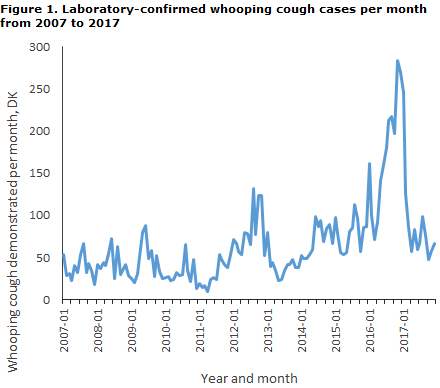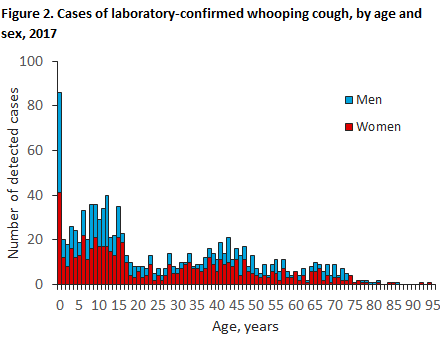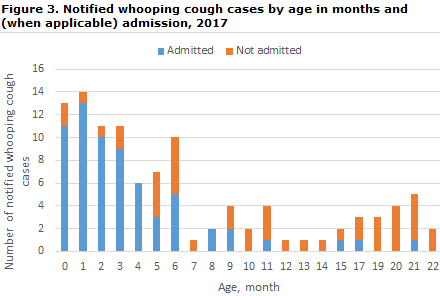No 16 - 2018
Laboratory-confirmed whooping cough 2017
Laboratory-confirmed whooping cough 2017
A total of 1,068 cases of whooping cough were detected in 2017. The highest occurrence was observed in Copenhagen, North Zealand and Funen, and the lowest occurrence was seen on the island of Bornholm and in North Jutland.
For a detailed epidemiological description of the 2017 occurrence, please see the 2017 annual report on laboratory-confirmed whooping cough.
In 2016, Denmark saw a whooping cough epidemic counting a total of 2,086 cases compared with a normal level of 500-1,000 annual cases. The epidemic ran from May 2016 until and including February 2017, Figure 1. For the rest of 2017, the level of detected whooping cough returned to its normal level.

As in previous years, whooping cough was mainly detected in young unvaccinated infants and older school children. Furthermore, a peak was observed among adults aged 35-50 years, Figure 2.

This age distribution is in line with data reported from other European countries to the ECDC (European Centre for Disease Prevention and Control) . The observed peak among adults in their thirties and forties probably reflects a combination of infection within families with children and an increased focus on testing of parents to children who are suspected of having whooping cough.
Whooping cough in children below 2 years of age
Laboratory-confirmed cases of whooping cough in children below 2 years of age are individually notifiable on Form 1515.
2017 saw a total of 107 notified cases of children under 2 years with whooping cough.
For a detailed epidemiological description of the 2017 occurrence, please see the annual report on laboratory-confirmed whooping cough in children below the age of 2 years, 2017.
Among the 107 notified children below 2 years of age, 57 (53%) were unvaccinated, whereas 16 (15%) had received all three whooping cough vaccinations (DiTeKiPol/Hib® or Hexyon®).
A total of 65 (61%) children were admitted to hospital for one or more days, Figure 3. Among infants below 5 months of age who had received a maximum of one vaccination, 49 of 55 (89%) were admitted. As shown, the young unvaccinated or partly vaccinated children are more affected by the condition and admitted to hospital.

Based on the notifications, no deaths due to whooping cough were recorded in this age group in 2017. Two of the notifications carried a statement that lacking childhood vaccination was due to deliberate opt-out.
Prophylaxis by use of antibiotics (PEP)
Fully or partly unprotected children below 24 months of age who are exposed to whooping cough infection should be offered prophylactic treatment with antibiotics in accordance with the guidelines described on the SSI website under Whooping cough prophylaxis following exposure to infection (In Danish) . Furthermore, it has been shown that the risk of developing pneumonia and the risk of admission and death among unprotected children who are exposed to infection may be reduced by vaccinating the child against whooping cough concurrently with the administration of PEP. The primary vaccine DiTeKiPol/Act-Hib® can be given as from two months of age.
Furthermore, it is important that the older siblings of infants are vaccinated as recommended.
Commentary
Whooping cough is a highly infectious bacterial infection that causes severe coughing spells, which in small children are characterised by a whooping sound when the child breathes in after the coughing spell. Whooping cough vaccination forms part of the vaccination programme at 3, 5 and 12 months of age and at 5 years of age. The aim of the vaccinations is primarily to protect infants against the infection that may run a serious course and which is occasionally life-threatening in this age group. Antibiotics can reduce the risk of infection, but will only rarely have an effect on the course of the disease, which may persist for as long as three months. Whooping cough in older children and adults can run a protracted and exhausting course, but is normally not serious. The cough is typically without the characteristic whooping sound, and the infection is therefore probably still underdiagnosed in adults.
Immunity following whooping cough vaccination or whooping cough disease only lasts for 4-12 years. Thus, the majority of the population is susceptible to whooping cough, which is also seen from the age distribution in 2017, when nearly half of all cases were detected in persons aged 20 years or above (48%). As infants do not receive relevant antibodies from their mother (unless the mother is vaccinated late in pregnancy), it is important to ensure that the two initial vaccinations given at 3 and 5 months of age, in particular, are administered without unnecessary delay.
Through a working group in the Vaccination Committee, the Danish Health Authority is currently assessing if the prevention of whooping cough among infants may be improved.
(T. Dalby, Infection Preparedness, Department of Bacteria, Parasites and Fungi, L.K. Knudsen, P.H. Andersen, Department of Infectious Disease Epidemiology and Prevention)
Link to previous issues of EPI-NEWS
18 April 2018